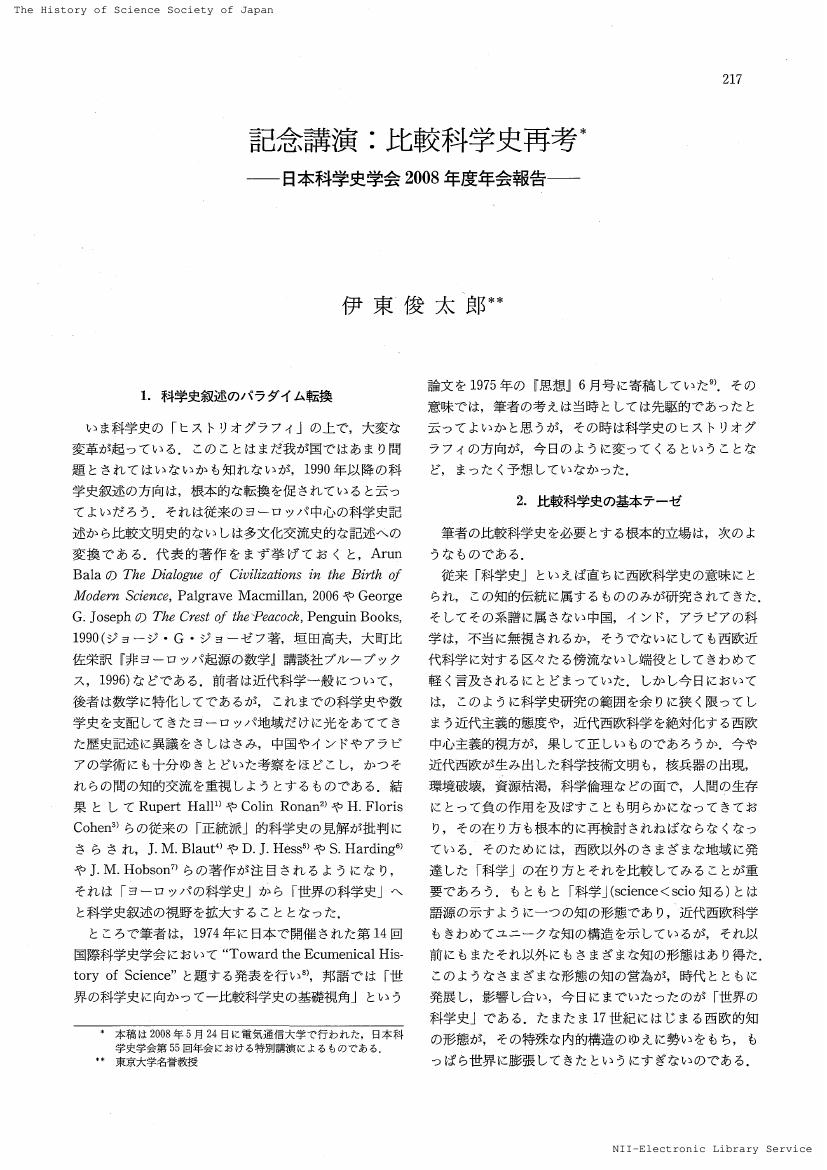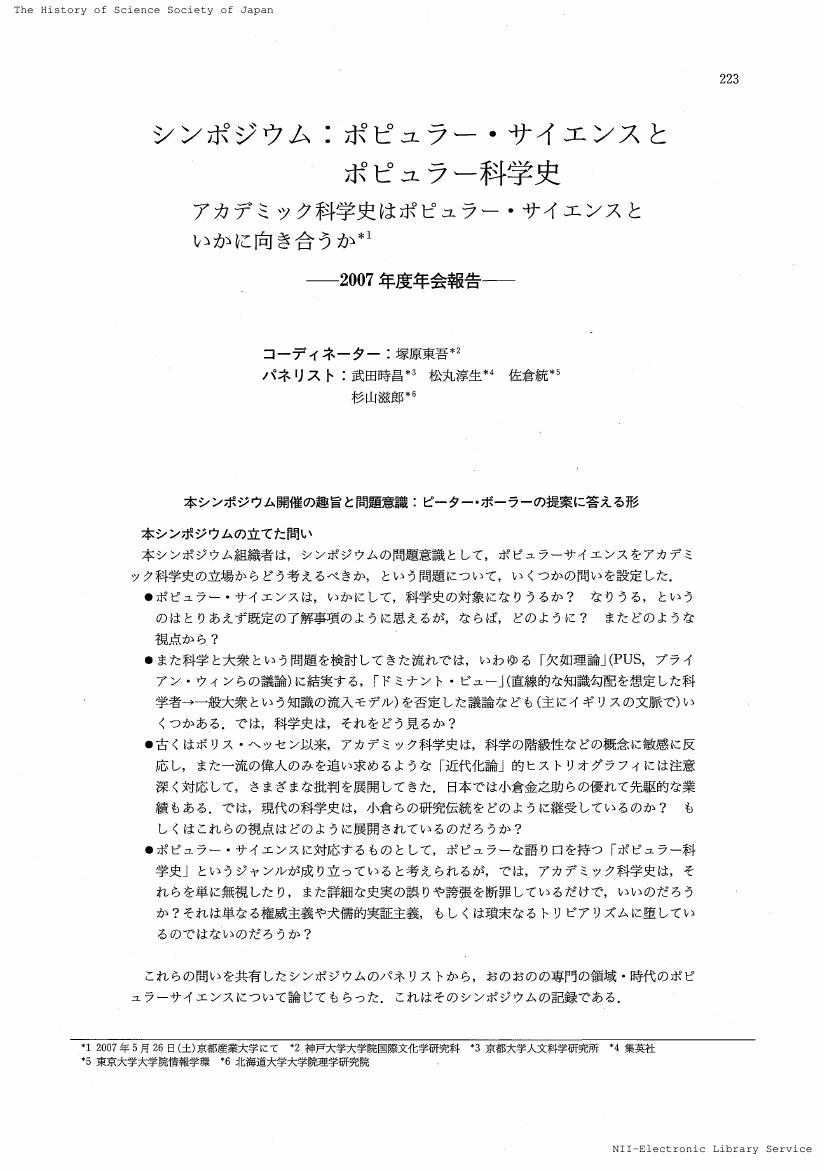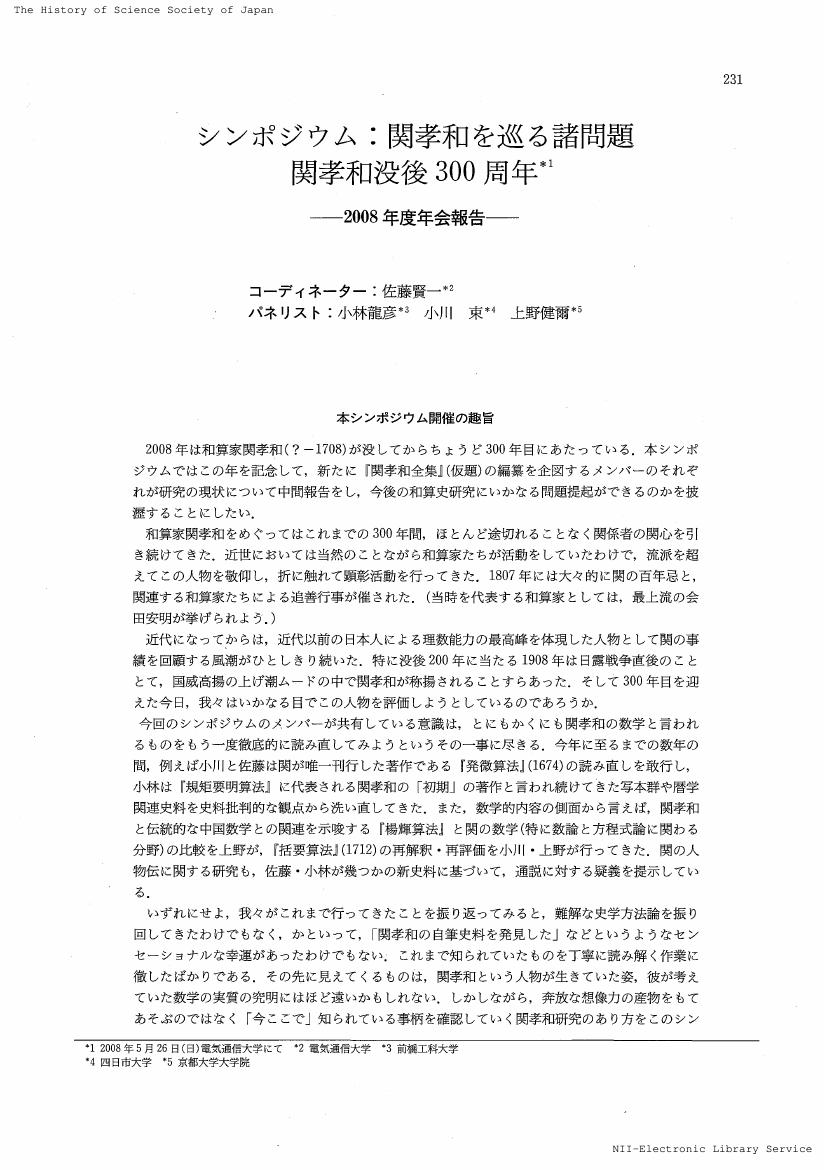- 著者
- 伊東 俊太郎
- 出版者
- 日本科学史学会
- 雑誌
- 科学史研究 (ISSN:21887535)
- 巻号頁・発行日
- vol.47, no.248, pp.217-222, 2008 (Released:2021-08-04)
1 0 0 0 OA 球惑星科学連合の地球科学史・地球科学論セッションを開催して(アゴラ)
- 著者
- 矢島 道子 山田 俊弘
- 出版者
- 日本科学史学会
- 雑誌
- 科学史研究 (ISSN:21887535)
- 巻号頁・発行日
- vol.47, no.248, pp.246-247, 2008 (Released:2021-08-04)
1 0 0 0 OA シンポジウム:関孝和を巡る諸問題 関孝和没後300周年-2008年度年会報告-
1 0 0 0 OA 紹介
- 出版者
- 日本科学史学会
- 雑誌
- 科学史研究 (ISSN:21887535)
- 巻号頁・発行日
- vol.47, no.248, pp.248, 2008 (Released:2021-08-04)
1 0 0 0 OA 日本における「平和のための原子(アトムズ・フォー・ピース)」政策の展開
- 著者
- 山崎 正勝
- 出版者
- 日本科学史学会
- 雑誌
- 科学史研究 (ISSN:21887535)
- 巻号頁・発行日
- vol.48, no.249, pp.11-21, 2009 (Released:2021-08-04)
In the early years of the Cold War, both the United States and the Soviet Union used their nuclear power technology as a diplomatic tool for expanding their political influence on respective friendly nations. On December 8, 1953, the United States initiated a new international nuclear program with President Dwight D. Eisenhower's "Atoms for Peace Address" before the General Assembly of the United Nations. This program regarded Japan as one of the most promising countries that could introduce nuclear power plants since it consumed a huge amount of energy while being short of natural resources. This paper studies the historical process of the atomic energy agreement between Japan and the US in 1955 using declassified documents in both countries. It shows that in spite of various proposals of the introduction of nuclear power plants into Japan including that of Congressman Sydney Yates, the final agreement was only for research reactors because American authorities felt that such proposals might mean an admission of US guilt in atomic bombing. It also argues that the agreement was one of steps toward the hegemony of bureaucrats and politicians in Japanese nuclear policy that made the leadership of scientists, especially those of the Science Council of Japan, decline.
1 0 0 0 OA 第2回日本科学史学会賞の報告
- 出版者
- 日本科学史学会
- 雑誌
- 科学史研究 (ISSN:21887535)
- 巻号頁・発行日
- vol.47, no.247, pp.176-179, 2008 (Released:2021-08-04)
1 0 0 0 OA 蔡倫以前紙に関する学術論争
- 著者
- 小林 良生
- 出版者
- 日本科学史学会
- 雑誌
- 科学史研究 (ISSN:21887535)
- 巻号頁・発行日
- vol.47, no.247, pp.150-159, 2008 (Released:2021-08-04)
During the past half a century archaeologists in China excavated some paper-like remnants dating from the Western Han Dynasty. Based on these findings, Pan Jinxing proposed that paper was invented before Ts'ai Lun, doubting on his contribution to the invention of papermaking technology. With the publication of new Academic Journal named "Paper History Study", China Technical Association of the Paper Industry Society members strongly opposed his opinions by re-analyses all of the unearthed papers and historical references. The major counter-evidences are as follows: a. there existed mis-judgments on produced ages of unearthed papers or paper-like objects, b. Some of the unearthed papers reported were not paper but paper-like objects made of botanical fibers bundles due to natural force or primitive paper-like models and the stormy discussion was made on the definition of paper, c. there are referential supports on the Ts'ai Lun's originality on the invention of papermaking. These conclusive remarks expressed by the Association of Paper Industry were compared with those of Pan Jinxing in the form of the table. The final conclusion on the existence of "the papers before Ts'ai Lun", therefore, must await further scientific analyses by the disinterested party.
1 0 0 0 OA シンポジウム:日本のコンピュータ史 研究開発における諸機関の連携-2008年度年会報告-
1 0 0 0 OA 第55回日本科学史学会年会・総会報告
- 出版者
- 日本科学史学会
- 雑誌
- 科学史研究 (ISSN:21887535)
- 巻号頁・発行日
- vol.47, no.247, pp.180-185, 2008 (Released:2021-08-04)
1 0 0 0 OA 紹介
- 出版者
- 日本科学史学会
- 雑誌
- 科学史研究 (ISSN:21887535)
- 巻号頁・発行日
- vol.47, no.247, pp.186-188, 2008 (Released:2021-08-04)
- 著者
- 金山 浩司
- 出版者
- 日本科学史学会
- 雑誌
- 科学史研究 (ISSN:21887535)
- 巻号頁・発行日
- vol.47, no.248, pp.193-205, 2008 (Released:2021-08-04)
In this study, I analysed the discourse of a philosophical dispute about the idea or theory of physics, which occurred in the first half of 1930-s in the Soviet Union. I examined the internal contents of the dispute between leading physicists and communist philosophers or old-generated technicians. This analysis has shown that against leading physicists such as Ia. I. Frenkel' or I.E. Tamm, their opponents such as V.E. Egorshin (communist philosopher) or V.F. Mitkevich (old-generation electrical engineer) insisted on the importance of materialistic/realistic interpretation of field proposed by Frenkel', which allowed the action in distance. Egorshin, based on Engels' philosophy, maintained the importance of the idea of energy as the reflection of the motion of real matters. Despite the ignorance (as pointed out by Soviet physicists) or bitterness of their discourse, the argument of the opponents is also understandable from their "anti-formalistic" tendency. This tendency has continued to form a base of the dispute about the philosophy of physics in the Soviet Union.
1 0 0 0 OA 明治期における技術者 : 近代技術確立をめぐる職人と職人的技術者(科学史入門)
- 著者
- 恒山 清爾
- 出版者
- 日本科学史学会
- 雑誌
- 科学史研究 (ISSN:21887535)
- 巻号頁・発行日
- vol.47, no.248, pp.206-209, 2008 (Released:2021-08-04)
1 0 0 0 OA 教材としての化学元素発見史(科学史入門)
- 著者
- 島原 健三
- 出版者
- 日本科学史学会
- 雑誌
- 科学史研究 (ISSN:21887535)
- 巻号頁・発行日
- vol.47, no.248, pp.210-216, 2008 (Released:2021-08-04)
1 0 0 0 OA 読書して学ぶベークマン : 独学者の学び
- 著者
- 本間 栄男
- 出版者
- 日本科学史学会
- 雑誌
- 科学史研究 (ISSN:21887535)
- 巻号頁・発行日
- vol.47, no.247, pp.140-149, 2008 (Released:2021-08-04)
Isaac Beeckman (1588-1637) is a self-learning man. He learned medicine by his reading medical books (contemporary and classic). In this paper I study how Beeckman read and understood them. He did not merely memorize them. But he gave some supplementary explanations to their (he thought) insufficient passages, sometimes criticized them and gave mechanical explanation that was based on atomism with hydrostatics. We can find similar ways of reading in the works of Lucretius and Cardano which young Beeckman read repeatedly. Beeckman learned the way of explaining natural phenomena with atomism from Lucretius' De rerum natura, and the way of explaining mechanics with natural philosophy and of demonstrating the principles of natural philosophy with machines from Cardano's De subtilitate. Beeckman's interactive reading is a good style of self-learning, but to avoid some bad effects of self-learning, he had to talk actually to a good respondent such as young Descartes.
- 著者
- 池上 俊三
- 出版者
- 日本科学史学会
- 雑誌
- 科学史研究 (ISSN:21887535)
- 巻号頁・発行日
- vol.47, no.247, pp.129-139, 2008 (Released:2021-08-04)
The Japanese optical industry started with the outbreak of World War One when the import of the optical weapons was suspended. The Imperial Japanese Navy made a decision to produce them domestically. The optical factory of the Naval Arsenal in Tsukiji succeeded in making an original rangefinder for preproduction purposes. In this paper, I would like to discuss the technology transformation process of the Japanese optical industry by verifying the technological progress of Japanese rangefinders. The database of the Industrial Property Digital Library is used. The early composition of the Japanese optical industry was the Naval Arsenal factory and two private companies closely associated with the government (i.e. Nippon Kogaku K.K. and Tokyo Gasu Denki K.K.). The new optical design technology (ray tracing method) was introduced to the Naval Arsenal by Kogoro Yamada from England independently from the German engineers whom Nippon Kogaku K.K. invited. However, due to the disarmament by the Washington Naval Treaty, the Naval Arsenal was closed and the optical factory of Tokyo Gasu Denki K.K. was also shut down despite its high technological level. As a result rangefinder and optical glass manufacturing technology was transferred to Nippon Kogaku K.K. from the Naval Arsenal which became a single powerful optical company. It was made clear in this paper that the technological level of the Japanese optical industry was self-reliant by early the Showa era through close cooperation between military, industry and academic.
1 0 0 0 OA 大村藩測量方峰源肋について(科学史入門)
- 著者
- 伊藤 節子
- 出版者
- 日本科学史学会
- 雑誌
- 科学史研究 (ISSN:21887535)
- 巻号頁・発行日
- vol.47, no.246, pp.112-115, 2008 (Released:2021-08-05)
1 0 0 0 OA 科学史と理科教育 : オカルト現象・擬似科学に踊らされない若者を育てるために(アゴラ)
- 著者
- 梅村 崇
- 出版者
- 日本科学史学会
- 雑誌
- 科学史研究 (ISSN:21887535)
- 巻号頁・発行日
- vol.47, no.246, pp.116-117, 2008 (Released:2021-08-05)
1 0 0 0 OA 紹介
- 出版者
- 日本科学史学会
- 雑誌
- 科学史研究 (ISSN:21887535)
- 巻号頁・発行日
- vol.47, no.246, pp.118-124, 2008 (Released:2021-08-05)
1 0 0 0 OA 南蛮宇宙論におけるクラヴィウス : ゴメス『神学要綱』中の天文学的数値をめぐって
- 著者
- 平岡 隆二
- 出版者
- 日本科学史学会
- 雑誌
- 科学史研究 (ISSN:21887535)
- 巻号頁・発行日
- vol.47, no.246, pp.95-111, 2008 (Released:2021-08-05)
In 1593-94, a Spanish Jesuit Pedro Gomez (1533-1600) completed his tripartite textbook for use by students preparing for the priesthood at Jesuit colleges in Japan. Its first part, De sphaera (On the Sphere), is well known as the first full-scale presentation of Western cosmology in Japan. However, it has been rarely noted that its third part, Compendium catholicae veritatis (Compendium of Catholic Belief), which treats theology, also contains such technical astronomical data as the dimension of the heavens. Comparison of Compendium's data with those seen in astronomy books in contemporary Europe has shown that some of the numerical values in fact correspond to those of a famous Jesuit mathematician Christoph Clavius (1537-1612), whose influence on De sphaera has already been indicated. This paper, while providing a modern Japanese translation of the related chapter in Compendium, first investigates the derivation of the data and, second, examines whether it influenced similar data seen in Kenkon Bensetsu (A Discussion on the Heavens and the Earth with Critical Commentaries) and its variant copy Tenmon Biyo (Compendium for Astronomy), both composed in the mid 17th century and attributed to the apostate Portuguese Chuan Sawano (Christovao Ferreira, ca.1580-1650).













